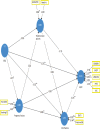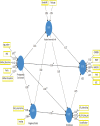Predicting child development and school readiness, at age 5, for Aboriginal and non-Aboriginal children in Australia's Northern Territory
- PMID: 38117820
- PMCID: PMC10732444
- DOI: 10.1371/journal.pone.0296051
Predicting child development and school readiness, at age 5, for Aboriginal and non-Aboriginal children in Australia's Northern Territory
Abstract
Background: Positive early development is critical in shaping children's lifelong health and wellbeing. Identifying children at risk of poor development is important in targeting early interventions to children and families most in need of support. We aimed to develop a predictive model that could inform early support for vulnerable children.
Methods: We analysed linked administrative records for a birth cohort of 2,380 Northern Territory children (including 1,222 Aboriginal children) who were in their first year of school in 2015 and had a completed record from the Australian Early Development Census (AEDC). The AEDC measures early child development (school readiness) across five domains of development. We fitted prediction models, for AEDC weighted summary scores, using a Partial Least Square Structural Equation Model (PLS-SEM) considering four groups of factors-pre-pregnancy, pregnancy, known at birth, and child-related factors. We first assessed the models' internal validity and then the out-of-sample predictive power (external validity) using the PLSpredict procedure.
Result: We identified separate predictive models, with a good fit, for Aboriginal and non-Aboriginal children. For Aboriginal children, a significant pre-pregnancy predictor of better outcomes was higher socioeconomic status (direct, β = 0.22 and indirect, β = 0.16). Pregnancy factors (gestational diabetes and maternal smoking (indirect, β = -0.09) and child-related factors (English as a second language and not attending preschool (direct, β = -0.28) predicted poorer outcomes. Further, pregnancy and child-related factors partially mediated the effects of pre-pregnancy factors; and child-related factors fully mediated the effects of pregnancy factors on AEDC weighted scores. For non-Aboriginal children, pre-pregnancy factors (increasing maternal age, socioeconomic status, parity, and occupation of the primary carer) directly predicted better outcomes (β = 0.29). A technical observation was that variance in AEDC weighted scores was not equally captured across all five AEDC domains; for Aboriginal children results were based on only three domains (emotional maturity; social competence, and language and cognitive skills (school-based)) and for non-Aboriginal children, on a single domain (language and cognitive skills (school-based)).
Conclusion: The models give insight into the interplay of multiple factors at different stages of a child's development and inform service and policy responses. Recruiting children and their families for early support programs should consider both the direct effects of the predictors and their interactions. The content and application of the AEDC measurement need to be strengthened to ensure all domains of a child's development are captured equally.
Copyright: © 2023 Dadi et al. This is an open access article distributed under the terms of the Creative Commons Attribution License, which permits unrestricted use, distribution, and reproduction in any medium, provided the original author and source are credited.
Conflict of interest statement
The authors have declared that no competing interest exist.
Figures
References
-
- Center on the Developing Child at Harvard University. The foundations of lifelong health are built in early childhood: Centre on the Developing Child, Harvard University; 2010. [Available from: http://developingchild.harvard.edu/wp-content/uploads/2010/05/Foundation....
-
- Moore T. Early childhood and long term development: the important of the early years. West Perth, WA: Australian Research Alliance for Children & Youth; 2006.
-
- He VY, Nutton G, Graham A, Hirschausen L, Su J-Y. Pathways to school success: Self-regulation and executive function, preschool attendance and early academic achievement of Aboriginal and non-Aboriginal children in Australia’s Northern Territory. PloS one. 2021;16(11):e0259857. doi: 10.1371/journal.pone.0259857 - DOI - PMC - PubMed
-
- Khan I, Leventhal BL. Developmental Delay. StatPearls. Treasure Island (FL): StatPearls Publishing Copyright © 2020, StatPearls Publishing LLC.; 2020.




